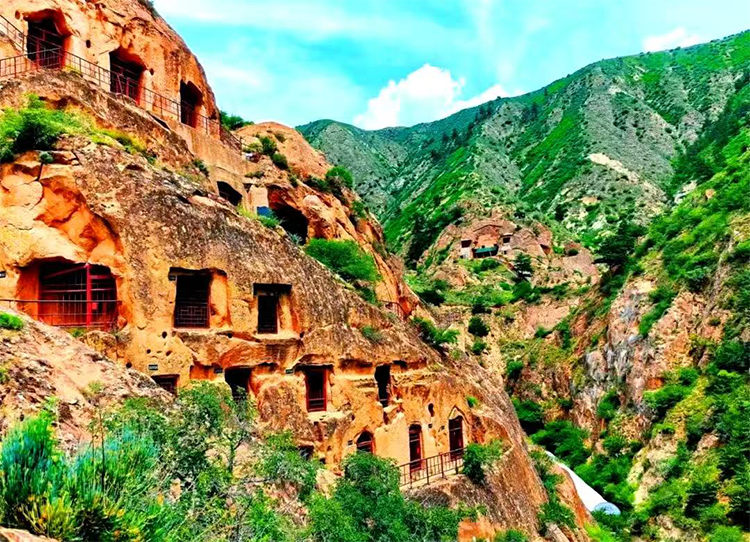Explore Xumi Stone Caves: Grottoes, Danxia Cliffs & Visitor Guide
Introduction
When the rust-red Danxia ridges awaken in dawn light and the millennia-old Buddhas on the cliff seem to smile, you have arrived at Xumi Mountain — Ningxia’s most mysterious grotto gallery. As a treasure of Buddhist art along the Silk Road, Xumi Mountain combines cave carvings that rival Dunhuang with blazing Danxia rock formations. Wander the winding walkways, let your fingertips trace Buddhist figures from the Northern Wei to the Tang dynasty, and imagine camel bells and Sanskrit chants echoing across time. This place is an epic where nature and culture collide — a meditative, time-traveling journey.
1. World-class double heritage: Millennia of dialogue between grottoes and Danxia
“Carve the rock into Buddhas; the mountain becomes a temple.” Xumi Mountain’s soul lies in the perfect coexistence of grotto art and Danxia geology. As one of China’s regionally important cave sites, 162 caves scatter like stars across crimson cliffs, and the Tang-era Great Buddha Hall houses a striking 20.6-meter statue. The entire mountain resembles a natural shrine; cinnabar sandstone walls glow gold in sunset, creating the extraordinary “Danxia Buddha Glow.” In 2013 the site was listed on the UNESCO cultural heritage tentative list as an open-air Silk Road art gallery.
2. Decoding the grottoes: A Buddhist art epic from Northern Wei to Tang
· A brief history of thousand-year carvings
Originally carved in the Northern Wei (386–534) and flourishing during the Sui and Tang dynasties, the grotto sculptures evolve from slender, austere figures to the fuller, ornate images of later periods — a visual record of Buddhism’s sinicization. Cave No. 5 preserves a Tang-dynasty Maitreya Buddha with neat curls, a gentle smile, and beautifully formed finger joints that astound visitors.
· A crossroads of Han and Tibetan arts
Look closely at Cave No. 45’s tantric White Tara and the Han-style flying apsaras in Cave No. 14: rare artistic fusions appear here. This is Silk Road exchange — Tibetan, Tuyuhun, and Tangut cultural influences meet, and even the lotus motifs on some cave ceilings show traces of Persian design.
· Details you must not miss
– Inscription key: outside Cave No. 1, the “Record of Xumi Mountain Restoration” documents Ming-era repairs
– Ingenious engineering: several cave drainage systems still function today
– Unsolved mystery: the damaged narrative painting in Cave No. 8 may depict Xuanzang’s pilgrimage, scholars suggest

3. Danxia secret realm: The earth in poetic flame
When sunlight sweeps across the “Xumi Pine Waves” area, the red layers look like scorching waves. Visit these photo and viewpoint spots at sunrise or before dusk:
– Danxia Sunset Terrace: sandstone folds create golden, vein-like shadows at sunset
– Chanfo Ridge: a natural stone pillar cluster resembling chanting monks; a 20-minute hike from the trailhead
– Silk Road Trail remains: stone steps worn by Tang-era camel caravans halfway up the mountain, aligning visually with the grottoes
Seasonal magic:
– Spring (April–May): wild peaches blossom, red rock dusted with pink
– Autumn (September–October): foliage turns vivid — best season for photography
– Winter snow spectacle (December–February): grottoes dusted with snow create a serene atmosphere (some paths may be closed)
4. Practical guide: Be a smart pilgrim
Transportation
– From Yinchuan: about a 3-hour drive (Qingyin Expressway + National Road 344), or take a coach to Guyuan then a tourism shuttle
– High-speed rail option: take the Yinxí high-speed train to Guyuan, then a taxi for about 1 hour (approx. ¥150)
Tickets and hours
– Peak season (May–October): ¥80 per person (covers grottoes + Danxia area)
– Off-season (November–April): ¥60 per person
– Opening hours: 08:30–17:30 (last entry at 16:00)
Tip: Reserve in advance via the “You Ningxia” mini-program to save ¥5.
Suggested itineraries
– Cultural Highlights (2.5 hours): Park entrance → museum → Great Buddha Hall → Xiangguo Temple caves → Danxia Sunset Terrace
– Deep Hike (4 hours): above route plus Chanfo Ridge → Silk Road Trail → Bodhi Pagoda
Food and lodging tips
– Local taste: “Bodhi Vegetarian” at the exit serves Xi Xia-style noodles and simple temple cuisine
– Where to stay: Guyuan city hotels (many offer shuttle service) or traditional loess cave dwellings for a homestay experience

5. Cultural extras and travel advice
– Beat the crowds: Tuesday and Thursday mornings tend to be least crowded. Bring anti-slip shoes for rainy season (July–August).
– Cultural event: a Buddha-unveiling ceremony is held annually on the lunar calendar’s fourth month, eighth day
– Accessibility: the Great Buddha Hall has accessible ramps, but the Danxia trails can be strenuous; assess abilities before hiking
Conclusion
At Xumi Mountain, every fissure in the rock holds a story and every carved Buddha freezes time. This site is not only a textbook example of Danxia geology but also a living fossil of Silk Road cultural exchange. When you trace the chisel marks left by Tang artisans and watch sunset drape the ridges in saffron robes, you will understand: some landscapes require reverence to fully reveal themselves.


